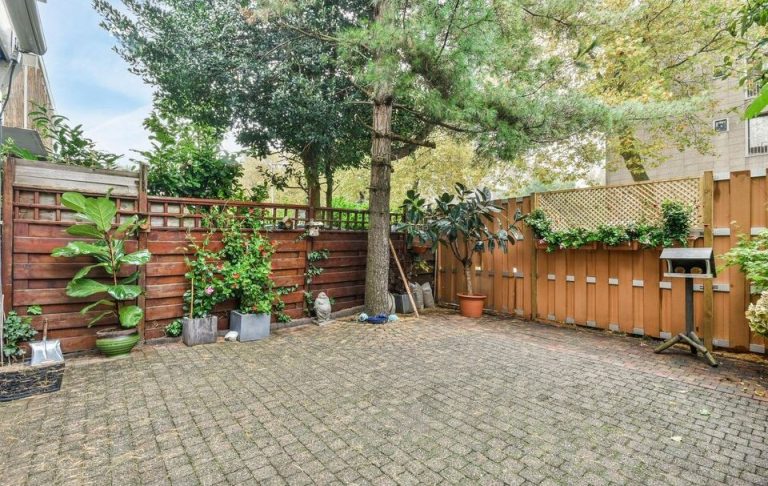Instead of being viewed as a limitation, a small backyard presents an opportunity to design a lovely, comfortable haven that feels like an extension of your house. Making the most of every inch is possible with careful planning and astute landscaping techniques. It’s not about having a large garden; rather, it’s about making the most of the available space to create an aesthetically pleasing and useful outdoor area. Making deliberate decisions that let your space shine is the key to small backyard landscaping.
Planning your design around what will work best for the space at hand is crucial, whether you’re remodeling a small courtyard or a suburban patch. Maximizing functionality while preserving aesthetic appeal is essential if you want a garden that really stands out. It’s easy to believe that a large yard is necessary to create a statement, but with the correct design decisions, even tiny areas can be impressive. Your small backyard can become a private haven with a little imagination and some motivational ideas.
Landscaping Features for Small Backyards
| Feature | Description |
|---|---|
| Vertical Gardens | Wall-mounted planters or climbing plants to save ground space. |
| Fire Pit | Small fire pits that serve as a focal point for gatherings. |
| Multi-Functional Furniture | Furniture that doubles as storage or can be folded away. |
| Artificial Turf | Low-maintenance, durable grass alternative for small yards. |
| Raised Planters | Planters that improve drainage and allow for better soil. |
| Water Feature | Small fountains or ponds for creating a calming atmosphere. |
| Plant Walls | Tall plants that create privacy while saving floor space. |
| Lighting | Solar or LED lighting to enhance ambiance and extend usage. |
| Hardscaping | Using materials like gravel or stone to create zones. |
| Low-Maintenance Plants | Plants like succulents and lavender that need minimal care. |
Making Wise Landscaping Decisions to Unlock the Potential of Your Backyard
The secret to landscaping a small backyard is to give equal weight to both functionality and aesthetics. Instead of attempting to fit everything in, think about what will add character to the room while still being useful. Not only does a well-designed yard look better, but it also feels bigger and cozier.
For example, vertical gardens work especially well in cramped areas. You can add greenery without taking up valuable ground space by growing climbing plants or building planters that are mounted on the wall. As a consequence, the garden appears lush and feels larger than it actually is.
However, multipurpose furniture can do wonders in a tiny backyard. Consider a dining table that folds up and can be stored when not in use, or a bench that can be used as a storage unit. These pieces of furniture maximize every available space, giving you the most comfort while taking up the least amount of room.
Innovative Backyard Landscaping Designs for Compact Spaces
The following tried-and-true landscaping suggestions will help you maximize the space in your tiny backyard:
1. Vertical Gardens to Get the Most Green Space
For bringing plants into small spaces, vertical gardening works incredibly well. It doesn’t take up much space to grow vegetables, herbs, or flowers. Without sacrificing important floor space, add lush greenery to your backyard with trellises, planter walls, or hanging baskets.
2. Use a fire pit to create a focal point
One of the coziest ways to improve a small backyard is to add a small fire pit. It is ideal for small gatherings because it not only adds warmth on cold nights but also instantly becomes a focal point. A small yard can feel very warm and inviting with a fire pit.
3. Make a Multipurpose Furniture Plan
Purchasing multipurpose outdoor furniture can significantly improve a small area. A multipurpose ottoman, folding dining table, or even a bench with concealed storage can all be used for multiple purposes, which is very useful when you’re working with limited space.
4. Artificial Turf Can Change the Ground
Consider artificial turf if your backyard is too small for a conventional lawn. Without the trouble of frequent watering and mowing, it adds a clean, green appearance to your area and is incredibly durable. For tiny areas that wish to have the feel of a lush garden without the commitment, it’s the perfect answer.
5. Define Space with Raised Planters
One of the most effective ways to grow plants in small yards is with raised garden beds. They improve soil quality, aid in drainage, and inhibit the growth of weeds, all of which contribute to the success of your plants. You can define distinct zones and add depth to your yard by placing these planters thoughtfully throughout it, giving the impression that it is larger.
Features of Intelligent Landscaping for Compact Yards
Here are some additional landscaping suggestions to enhance the aesthetics and usability of your tiny backyard:
6. Select a Minimal Water Feature
A little water feature, such as a pond or fountain, can add calm and relaxation to your area. In small backyards, water features are especially useful for establishing a tranquil atmosphere. When surrounded by lush vegetation, they can even serve as a natural privacy barrier.
7. Use Plant Walls to Increase Privacy
Plant walls are a great way to add privacy without taking up a lot of room for people who live in close quarters. Bamboo and climbing ivy are two examples of tall, bushy plants that can create an effective screen, letting you enjoy your outdoor area without being bothered by onlookers.
8. Use Intelligent Lighting
After sunset, well-chosen lighting can make your tiny backyard feel safe and welcoming. To illuminate pathways or draw attention to your favorite garden elements, think about utilizing solar-powered lights or LED string lights. Lighting not only enhances the atmosphere but also highlights the most appealing features of a small yard, giving the impression that it is larger.
9. Use Hardscaping to Create Zones
Dividing your backyard into discrete areas can give the design structure and give the impression of more space. Divide your backyard into a dining area, a lounge area, or a garden using various materials like wooden decks, gravel, or stone paths. The overall flow and feel of the space will be improved by each zone feeling like a separate mini-room.
10. Employ Plants That Require Little Care
Plants that require little care are essential when working with limited space. Choose hardy plants that need little watering and maintenance, such as ferns, succulents, or lavender. In addition to being incredibly resilient, these plants also provide texture and color without requiring continual care.


